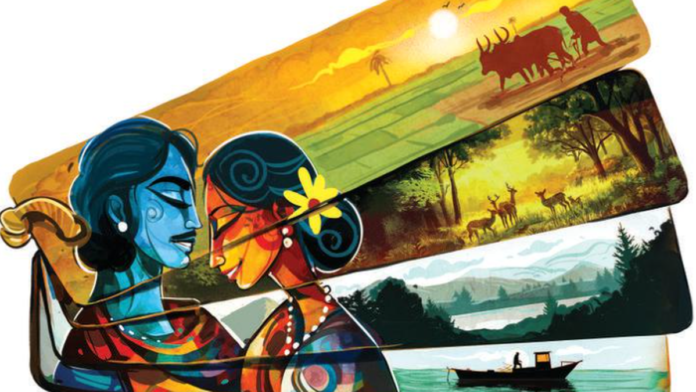Once I wrote that perhaps, the ‘Kutru’ (utterance) in the ancient grammatical work Tholkappiyam could have become ‘koothu’, indicating theatre. This “atrocious statement”, as it was described, stirred up a hornet’s nest. I was hauled up by one traditional Tamil scholar, who argued that Tholkappiyam had only reflected the way of real life of the Tamils and that “the treasure-house of the ancient Tamil culture, which what Tholkappiyam is”, could not have portrayed a fictional life on the stage.
I do not want to enter into the philosophical domain to discuss whether art is real and life is an illusion, or life is real and art is an illusion, but I can say that all the ‘aham’ (love) poems that depict life as found in the Sangam classics, thereby providing a classical blue-print of illustrations for the Tholkappiyam grammatical rules and regulations, follow such a rigid and strict convention without any deviation whatsoever that one cannot but visualise that kind of life is just fiction.
Five geographical regions
The Tamil country is divided into five geographical regions. The hills, the plains, the pastoral regions, the coastal area, and the arid barren lands. In the hills, providing the romantic environs, the premarital love (punarchi or sexual union) is the main theme of all these poems, which are in the form of either dramatic monologue or dialogue. The plains, rich and fertile, portray an affluent life, where there are frequent quarrels (uutal or feigned anger) between the lovers, who are now married. The husband has social obligations, too, and when he goes on such missions, the wife patiently waits for him in the pastoral called mullai. Excellent visuals such as sunset in autumn, sounds of the cattle slowly walking back home, chattering rain, and distant thunder distinguish these scenes of dramatic poetry in this geographical division. The sea always reminds one of the dividing line, and the drama visualised in this region is characteristically brought out as slings and arrows of romantic agony. It is possible that many of these dramatic poems had been existing much before Tholkappiyam, and only later were they collected and classified on the basis of which Tholkappiyam could have set forth its grammatical rules.
There are a few poems in ‘aham’ poetry of dramatic import, which now look like totally different from the main stream thinking, as what had been stipulated by Tholkappiyam. According to Tholkappiyam, the hero and the heroine, who fall in love, must be extremely good-looking, endowed with all the textbook qualities, nobleness, and virtue, and also belong to the same economic and social class. Mercifully, there is no mention of caste!
There is a beautiful drama portrayed in one of the Kalitogai poems that can be described as ‘rebel theatre’ that defies convention. In one of the poems, a hunch-back woman and a dwarf, who are in the autumn years of their life, fall in love. Nature has wronged them physically, but it has not meddled with their indomitable spirit. Leslie Fielder has said that in those days, people really believed that God had created freaks to provide amusement for the children and the wealthy. No wonder therefore, the hero and the heroine are always at the receiving end. But in each other’s company, they appear to be in an overwhelming stature. They appear on the stage in no less presence than that of a conventional hero or heroine. Their wit, their playhouse irony and, above all, their natural ability to laugh at themselves without any inhibition elevate them to a much unusual romantic throne than that of a normal pair.
Set in darkness
Let us see the play. The stage is in darkness. In the dim light that comes in, we see a hunch-back (late middle-aged woman) entering from the right corner of the back stage and she moves quickly in, like a snake in the waters, towards the front stage. In the left corner of the back stage, a dwarf (a man of the same age as the woman) watches her with amusement. He walks in measured steps towards her. Bright lights. She gives him an angled look. Both of them are in simple dress that announces their economic status. They are servants in that house.
The dwarf addresses her in a mock-heroic fashion, imitating an epic hero’s idiom of stylized speech. “Oh! Gracious lady! Your Excellency moves like a wavering shadow in the running waters of a sacred river. I salute thee.” Feigning anger but not concealing her admiration for him, she retorts: “Look, who is making fun of whom! A dwarf! Aren’t you less than a man? Am I in anyway inferior to you, you son of a bird? You walk like an upright tortoise, with both your hands firmly holding your waist and what a grace, my God.”
Many sub-texts
While engaged in this wordy duel, they strut around the stage, chasing each other. These dialogues can be sung in a stylistic fashion which would make it a musical parody. But the tragi-comedy built up in the construction of this beautiful poem should not be lost in the dramatic production by eliciting emotions of sympathy or pathos. The dignity of presence of these two characters should be visible. This poem apparently looks frivolous on the face of it, but carries many sub-texts that make it refreshingly modern. It reads like a Samuel Beckettian creation, a classical text for the absurd theatre.
(The writer is a well known author and playwright).
Published – November 21, 2024 11:03 pm IST
